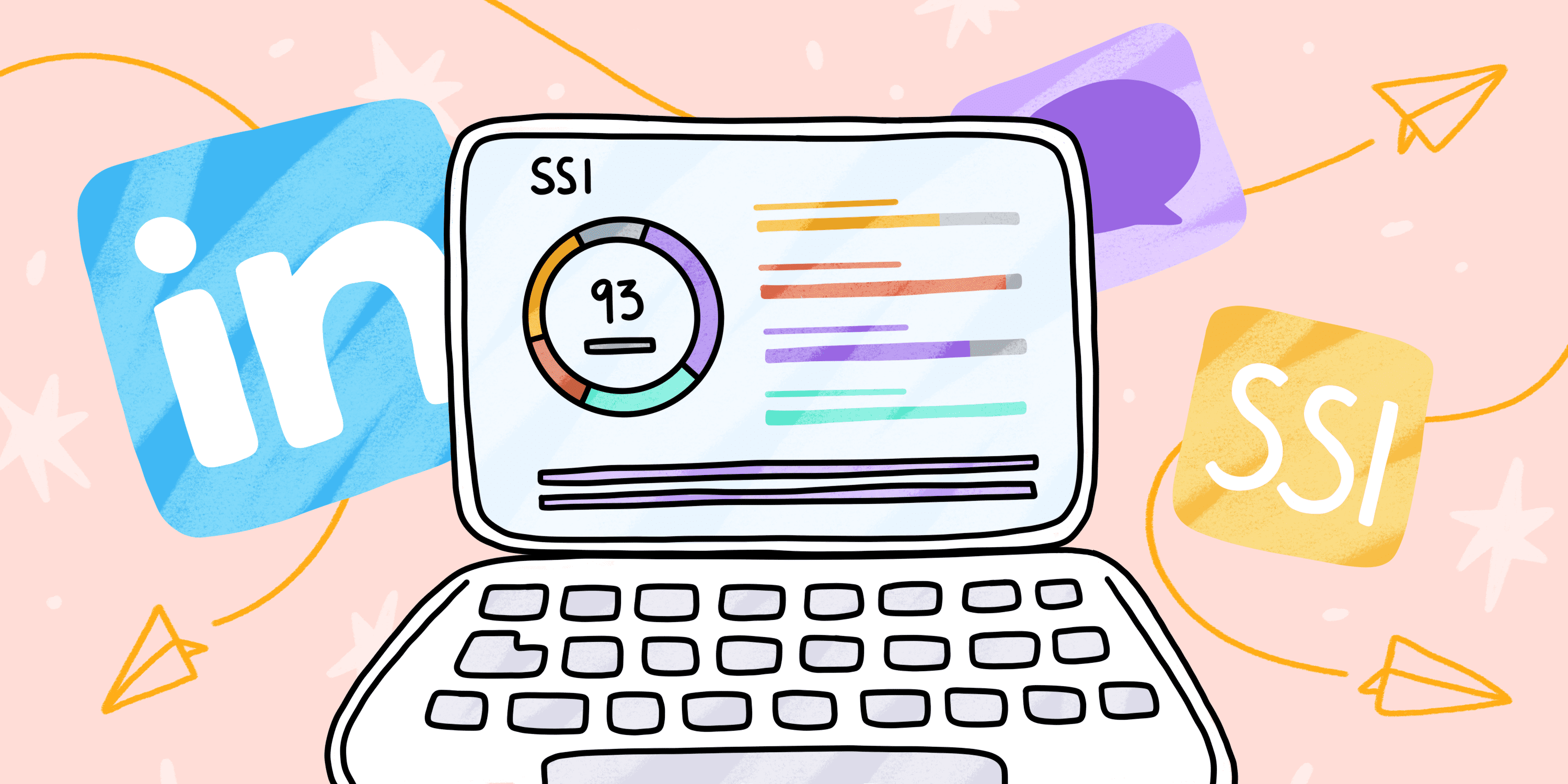You’ve probably heard of social selling, right? If not, we’re here to spill the beans on this game-changing approach that’s all about building connections and nurturing relationships with your target prospects via social media.
Curious if this technique can work wonders for your company? This social selling tutorial will show you just how impactful it can be for your business, backed by some eye-opening statistics.
Let’s get this party started!
Outline:
What is social selling?
Don’t mix it up with social media marketing or advertising; it’s a different beast altogether.
Social selling is a sales technique that involves connecting and engaging with your target sales prospects directly on social media platforms like Facebook, LinkedIn, Twitter, and more.
It’s the new-age antidote to cold calling and does not involve any aggressive or direct selling tactics. Instead, it’s all about channeling social media engagement and activity toward the sales cycle, nurturing two-way communication, and ultimately closing bigger business deals compared to traditional digital marketing strategies when done right.
Benefits of social selling: Statistics
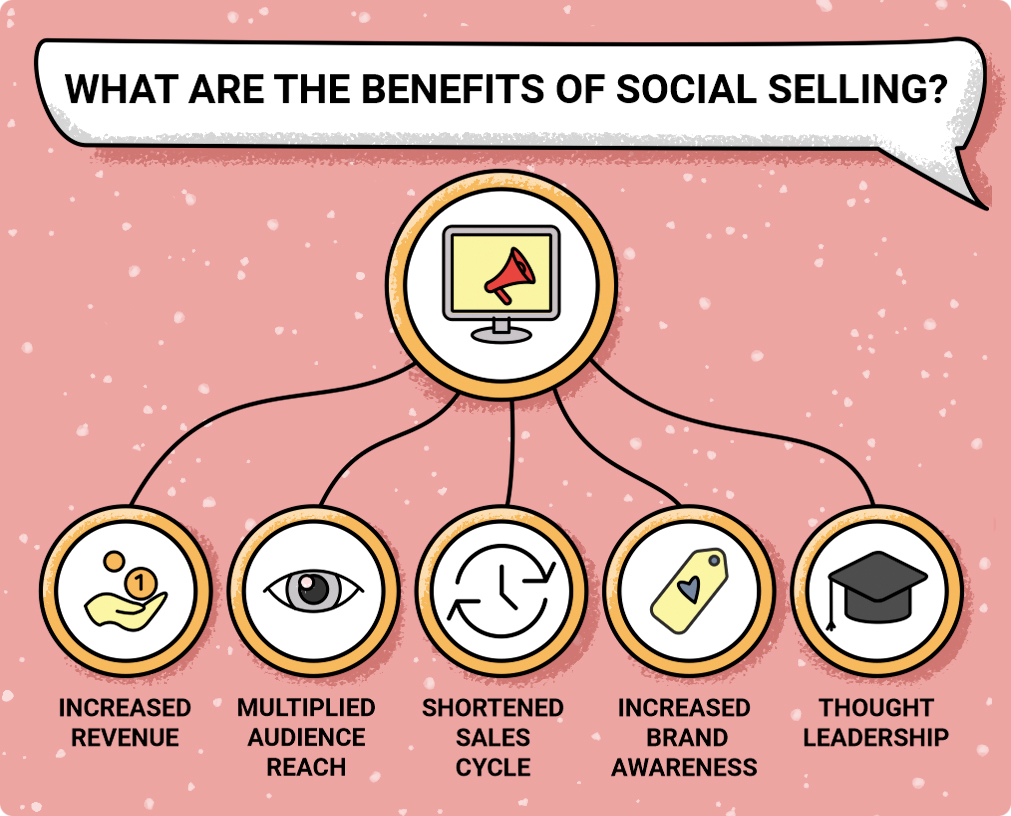
Now let’s explore the benefits of social selling. While not a new concept, it remains an undervalued, underutilized, and underappreciated sales and marketing approach that deserves some serious love.
I mean, look at these recent social selling stats from OptinMonster:
- 76% of buyers want to have social media conversations with potential providers;
- 78% of salespeople who use social selling are outselling peers who aren’t;
- 84% of C-Level executives use social media to make purchasing decisions.
And that’s just the tip of the iceberg. According to the Digital 2021 October Global Statshot Report by Hootsuite and We Are Social, more than half a billion people joined various popular social media platforms during COVID-19, leading to a total of 4.5 billion social media users.
Still not sold? We’ve got even more stats to show you just how transformative social selling can be for your business. From increased customer loyalty to higher sales quotas, the numbers don’t lie:
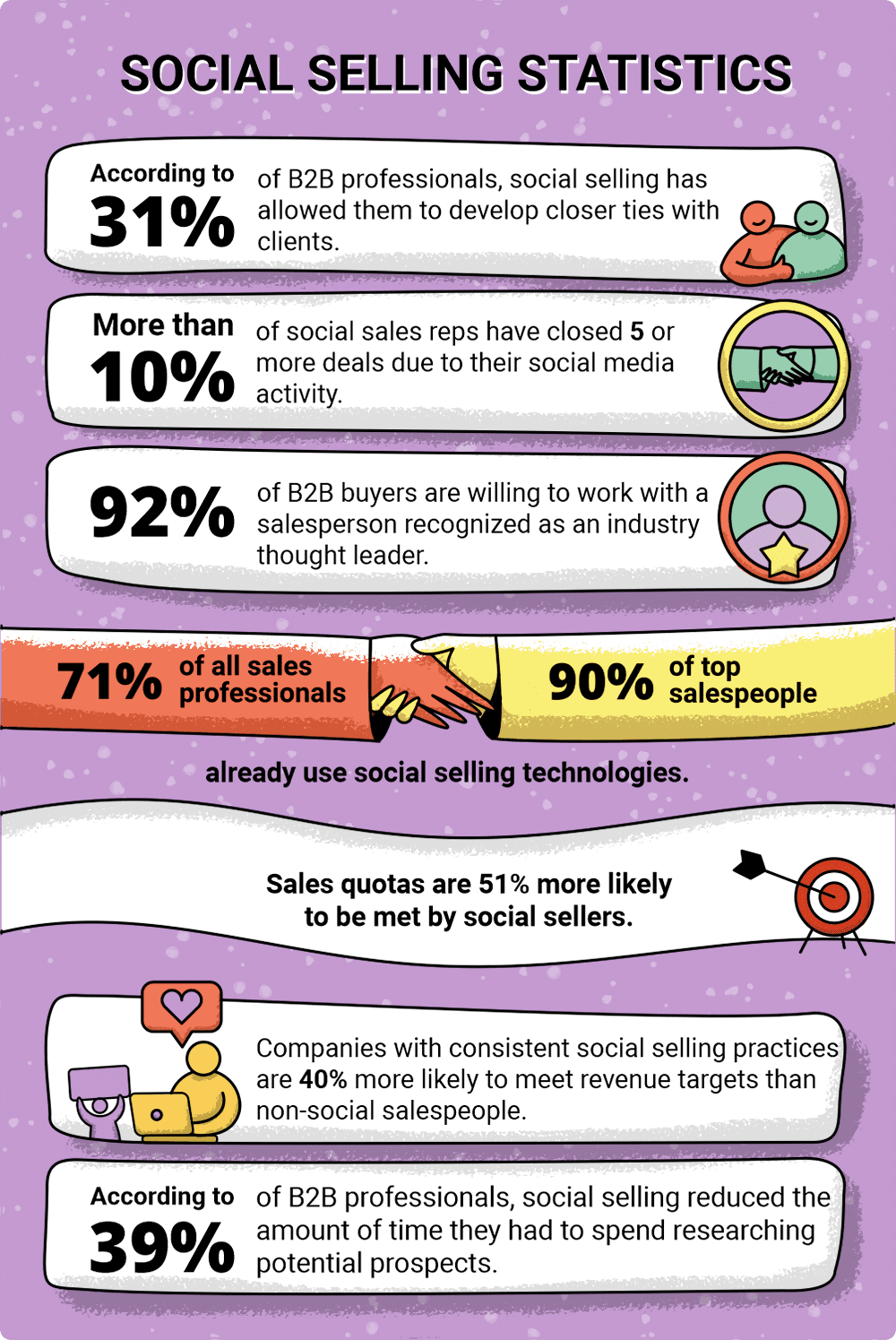
Social selling success stories
To prove the above, here are a few practical cases from businesses that benefited from social selling.
 Case 1. Christopher Ulrich, CEO & Founder of Direct Response Group
Case 1. Christopher Ulrich, CEO & Founder of Direct Response Group
Christopher used LinkedIn to supercharge his B2B social selling. First, he optimized his profile to showcase his expertise, then started sharing valuable content and engaging with his target audience. He also used LinkedIn Sales Navigator to identify potential clients more efficiently.
The result? A whopping 35% increase in sales and a 50% increase in engagement with prospects within six months. That’s a return of approximately $12 in revenue for every dollar spent on LinkedIn Sales Navigator! Talk about a success story!
 Case 2. Alex Mastin, CEO & Founder of Home Grounds
Case 2. Alex Mastin, CEO & Founder of Home Grounds
Alex’s company catered to both B2C and B2B audiences, so when a coffee equipment supplier approached him, he saw an opportunity for social selling. They created targeted content and engaged with potential customers on social media, primarily focusing on LinkedIn and Twitter.
By connecting with decision-makers and building trust through personalized conversations, they saw a significant increase in sales for the supplier. And the cherry on top? Lasting relationships with B2B customers that continued to grow their community and brand.
So, as you see, social selling has become a critical component of modern sales strategy, and the key to success is focusing on the social, not the selling. To help you do that, we have a round of handpicked, custom-curated social selling tips to consider.
Tips and strategies to get started with social selling
To begin, create a company account on the social media networks your target audience uses if you haven’t already.
Since Facebook is the most popular platform in terms of user volume, it’s a wonderful place to start. Twitter, LinkedIn, Instagram, Pinterest, and perhaps Snapchat are other venues to consider.

Social Selling On LinkedIn: A Step-By-Step Guide
15 March 2024
Now that you’re all set up, let’s talk about some valuable tips to help you connect with your target audience and establish rapport through social selling:
1. Network effectively
Leverage multiple social platforms to reach more potential customers. Share presentations, landing pages, videos, and audio on all your company’s social media profiles, with relatable captions to draw in your audience.

2. Serve first, sell second
Showing you’re human and building genuine relationships are excellent social selling strategies. Still, professional salespeople must deliver value before others will believe what they’re saying. Just because someone opted in or expressed an interest doesn’t mean they’re begging you to sell them stuff.
Serving before selling entails freely disseminating important information. It involves finding answers to problems without putting a monetary value on them. You’ll be on the correct route if you ask, “How can I help you?” rather than “What can I sell you?”
3. Don’t overlook existing customers
Many businesses use social selling to focus solely on forming new contacts. However, it’s also critical to maintain relationships with your existing consumers.
Getting a new customer might be five times more expensive than keeping an old one. And, if a person buys from you once, they’re more likely to buy from you again … as long as the relationship is maintained.
Encourage your existing clients to follow you on social media networks if they haven’t already and engage with them regularly!
4. Channel digital marketing efforts
Once you’ve created a social network page to increase your audience, you will see good traffic generated. Loyal and potential customers will engage with your content and share your webpage, leading to better brand visibility and recognition.
To maintain this traffic, you should ensure you’re responding to all comments and queries to function smoothly.
Also, make it a point to learn how to use other different types of marketing together with social selling to support your business growth.
5. Pay attention to what others have to say
On social media, people enjoy ranting about their lives. Their raving could be an excellent opportunity for you to step in and fill in the blanks.
Your followers are likely to share information about their wants and needs. Look for tips and pain points in messages and mentions. Being able to help others with these issues will provide you with a realistic chance for social selling.
6. Make a list of companies you’d like to work for and keep track of them
Do you ever fantasize about landing a big-name client?
I sure do.
It doesn’t have to be only a dream, though.
Small businesses and major enterprises can be found on Twitter, Facebook, and LinkedIn through company profiles or accounts. You can stay up to speed on corporate news by following these brands, such as when they win an award (and you can send them a “Congrats!” message) or when they ask for product recommendations (and you can send them an invite to a demo).
If you’re a marketer, this is similar to how you’d approach your account-based marketing plan.
Here are some options. Make a list of 5 to 10 dream companies active on social media and start following them right now. When you can, like, retweet, and comment on their status changes. It’s possible it won’t be a dream for much longer!
7. Use a geo-targeted search engine
Location-based targeting is available on social media platforms. This enables marketers and sales reps to distribute promotions to a specific group of people. They can offer gated content to customers and collect feedback through lead generation advertising or polls.
8. Offer special deals
Everyone loves free stuff, so try holding sweepstakes or doing social media giveaways. People adore promoting these types of campaigns on social media, and by incorporating an entry form, you’ll be able to collect valuable lead information.
Make sure to provide a means for people to share the offer on social media at the bottom of the form. This way, participants can spread the news to their networks, and you can continue to nurture the relationship by engaging with and acknowledging their postings with each mention.
9. Use a refer-a-friend strategy
Referral programs can be complex, but if you play your cards well, they can be a terrific way to engage your audience.
Referrals are an excellent method to break the ice with prospects, with 92% of customers believing the recommendations of their friends and relatives.
Create enticing rewards for both the referrer and the referees, such as a gift card or cash. It could be the final push your clients need to promote you to their friends and colleagues.
You can quickly build up a referral campaign that spans major social media sites with a social application coupled with your marketing automation platform, allowing you to grow your customer base quickly.
You’ll be able to watch the campaign’s progress and efficacy since each shared message will have a unique link that tracks replies at every stage of the conversion event. You’ll also be able to see how prospects are helping to spread the word.
Here’s an example of a referral campaign for Marketing Nation Online, our annual event. For a chance to win an Amazon gift card, participants were encouraged to refer their friends via social media.
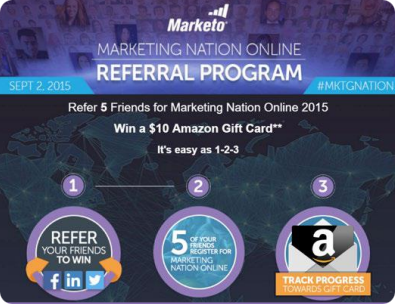
10. Leverage social selling software
Social selling software gives you a nitty-gritty understanding of the lead age (creation date – conversion date) so that you can target them focused on their necessities.
With such software, you can learn about the changing requirements, which helps benefit and improve your product or service.
Here are some of the popular social selling tools:
LinkedIn Sales Navigator
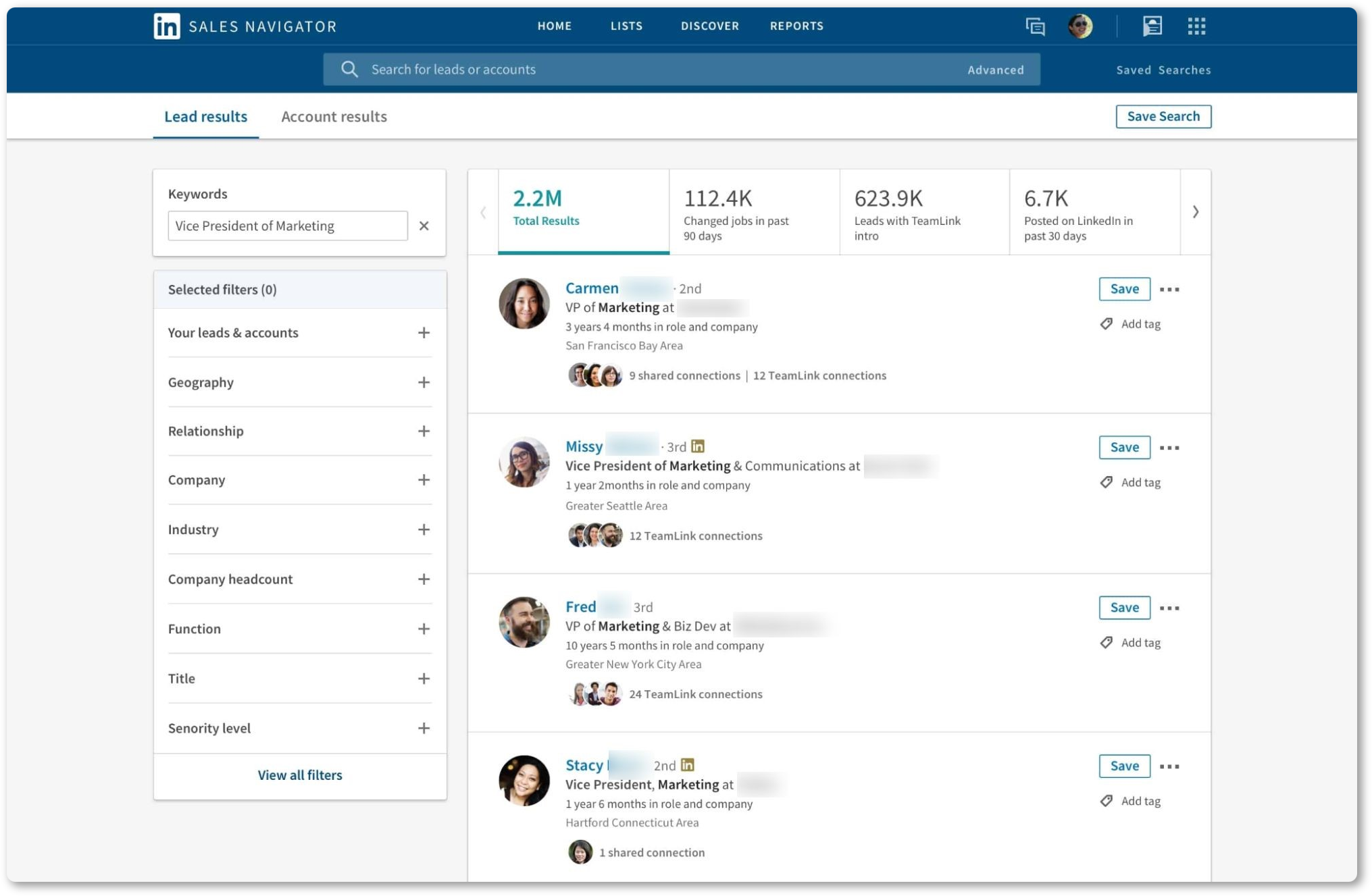
LinkedIn Sales Navigator is the most powerful networking tool for B2B sellers. It expands the limits beyond regular LinkedIn accounts to see profiles and engage with them.
Search filters allow you to narrow down search results and enable salespeople to network with C-Level executives. You can also build your lists based on leads and accounts — the tags come in handy!
Mentionlytics
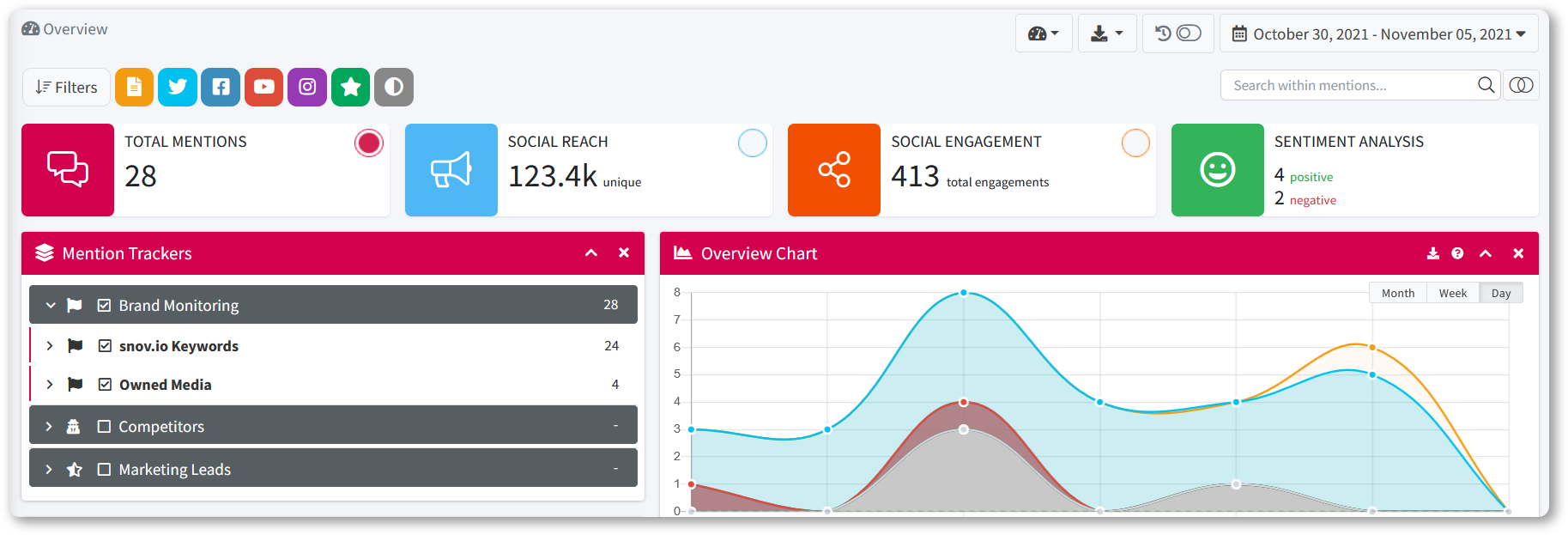
If you’d like to monitor client interactions and market trends, Mentionlytics is a great social media monitoring tool. Participate in client discussions and leverage opportunities for social selling. Help your buyers make an informed purchase decision and improve brand responsiveness.
Snov.io Email Finder
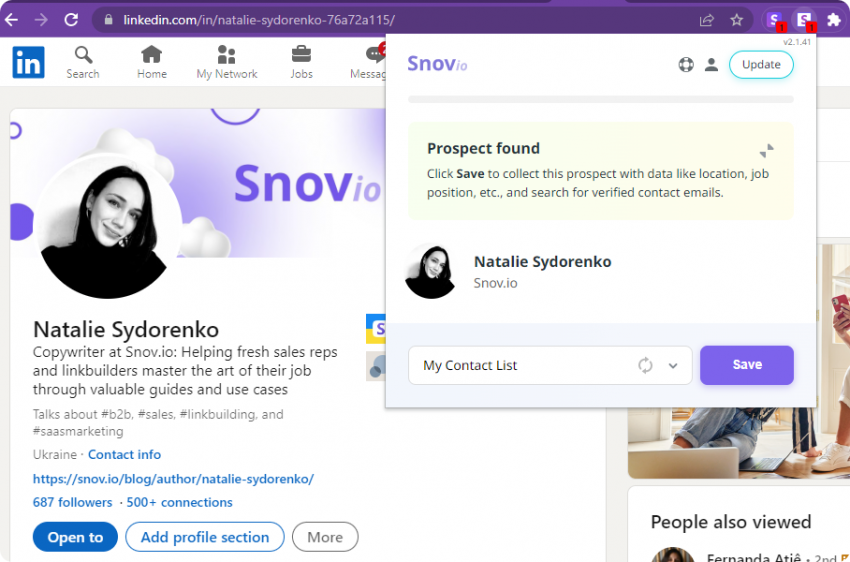
Do you want to collect employees’ email addresses from a specific company? It’s easy if you have a domain of the company you’re interested in. Or its profile on a social network! Or employees’ social media pages! Snov.io Email Finder will help you with that. Use this feature to add quality contacts to your sales funnel.
You can learn more about how to use the tool here. And when you’ve found the right leads, you can automate your outreach campaign using the Snov.io toolset.
Hootsuite
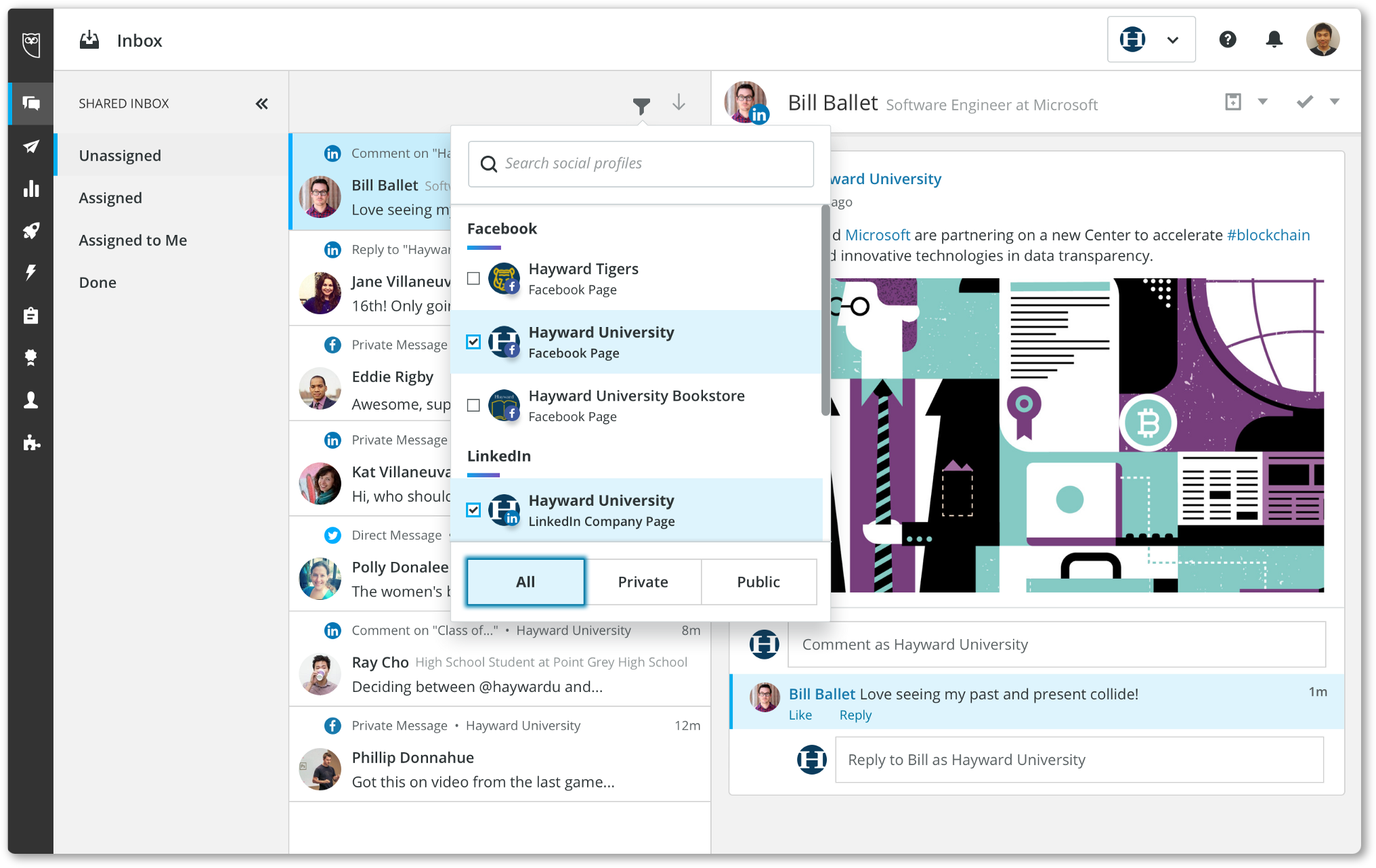
Hootsuite’s customizable dashboard offers a single window to view a substantial amount of content across all social platforms. You can customize your social media channel posts and limit yourself to the content you’d like to see.
Besides, Hootsuite allows you to monitor and track what people are saying about your brand and provides an easy interface to respond to post comments and feedback instantly.
HubSpot
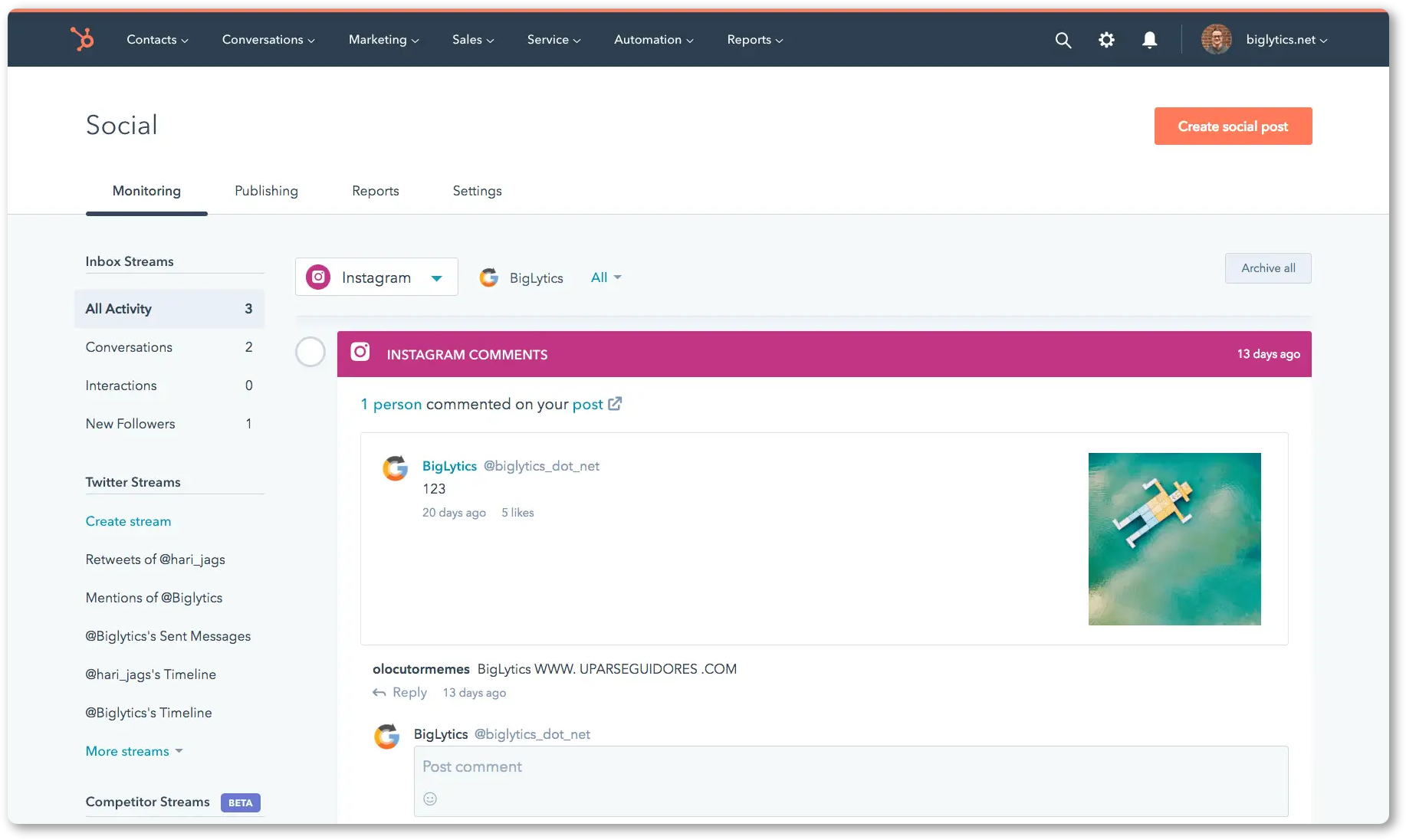
HubSpot’s monitoring tool lets you view all inbox activity, including new followers, track customer interactions, and integrate follow and follow back options.
Its social report tool offers reports on the audience, published posts, interactions, clicks, shares, impressions, sessions, new contacts, and top positions in the form of simplified graphs and charts. You can also attribute leads to specific sources, enjoying an extra benefit of Business Intelligence (BI).
Brandwatch
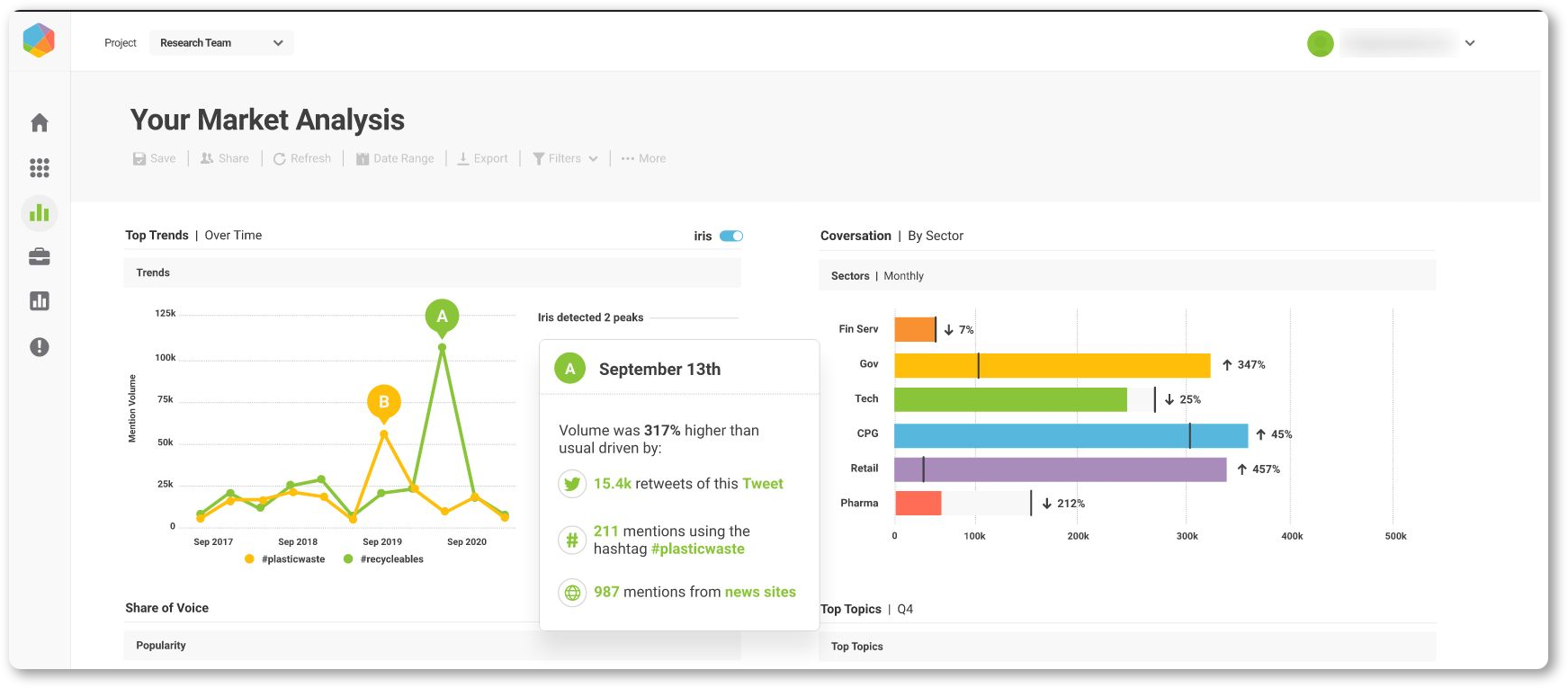
Brandwatch Analytics is a capable analytics platform that includes features like extensive social listening and influencer identification tools. It’s a great market research tool for getting real-time analytics, keeping an eye on market trends, and identifying influencers to expand the reach of a campaign.
Brandwatch allows you to customize tools to meet specific needs, analyze and study conversations about your brand, and find new ideas, innovations, or opportunities.
Nurturing social selling efforts with the right platform and information would give you the upper hand you need for development and attainment. When your target audience is compelled to notice your content and learn more about your product or service, the number of leads generated will be tremendous.
11. Host a live occasion
Hosting a live event for your brand expands the horizon.
You can also utilize social media platforms to inform and attract potential leads in advance. Those brands are likely to grow faster who are socially interactive with their loyal and potential customers.
Live sessions don’t need to be a large vent or meet-ups. Creating a live chat session on the Facebook live page to answer FAQs is enough to increase brand recognition.
12. Create and share valuable content
Creating, distributing, and promoting valuable content is one of the best ways to attract prospects and skyrocket your sales. As a part of your social selling strategy, you can use content to engage your audience and boost interactions for the greater good of your brand.
You can use Ahrefs, an exceptional research tool for creating engaging content. Just enter keywords and get a list of popular articles based on their online performance. The tool collects statistics such as social search, organic traffic, referring domains, etc., to measure the performance of a piece of information, giving you a deeper insight into how interesting a given topic is to a particular audience.
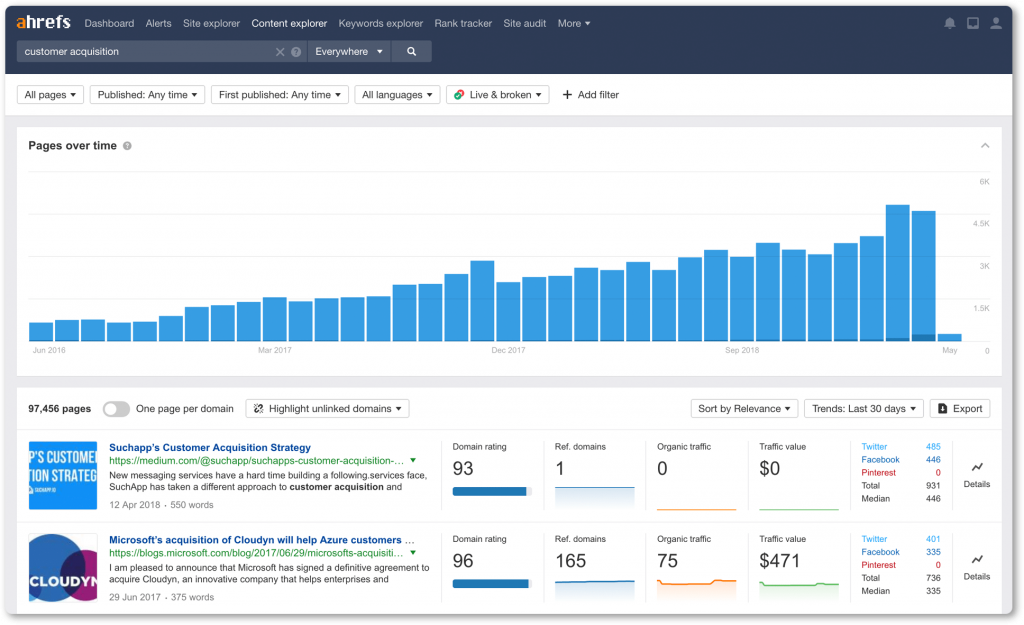
To blend content and social selling, you can publish blogs and articles relevant to your target segment. Further, you can ask open-ended questions, post catchy infographics, respond to comments, and share freebies or downloadable content.
All these efforts, when done right, will help you attract more leads from popular social networks.
13. Set up references and tracking alerts
You can create reference campaigns to enter other social media platforms, gatherings, and groups through one social media page.
By tracking customers on different platforms, it’s easier to pace further and achieve the mission goal. Sending one message to other platforms through references and then following the reactions gives businesses a chance to build a prospective layout and content that helps create more and more traffic.
All set to leverage social selling?
The best way to overcome challenges while making it in your business niche is by mixing the sales and marketing strategies out there. Start experimenting with social selling and embrace learning as your core skill. Practicing the key social selling business strategies mentioned in this blog post will help you stand out from the crowd.
Though social selling and social media marketing seem similar, they’re pretty different. Both are powerful ways of converting customers and, together, could result in extremely high conversion rates for your company.
With a scalable approach like social selling, both small and large companies can achieve sustainable growth. To build a loyal community of your target audience does require hard work and a bit of creativity. The efforts, however, will pay off quickly.
Invest some time to think about your audience and its preferences. Crafting campaigns based on the audience’s interests will make enhancing brand awareness and loyalty relatively easy.
Make some informed decisions and see how you can leverage social selling strategies to promote your brand and fatten up your ROI.
Good luck!




